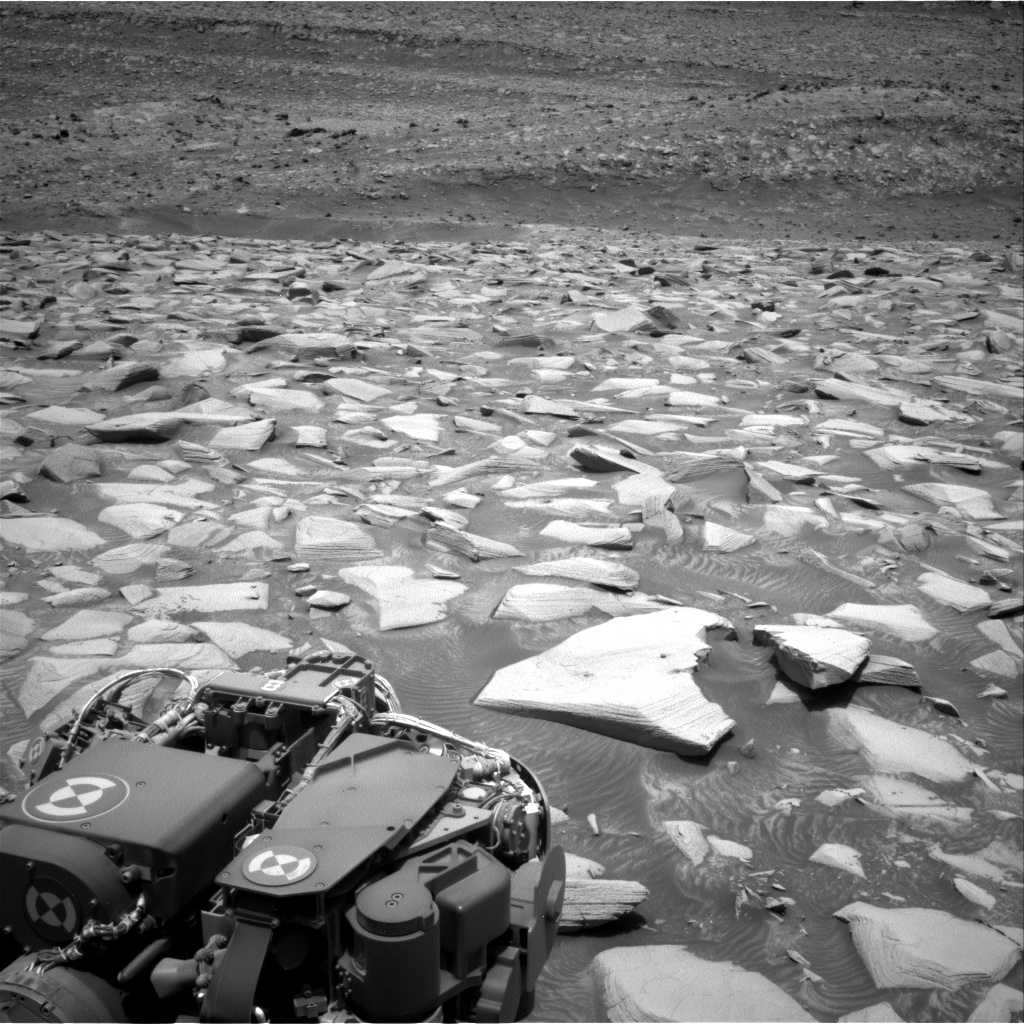Curiosity Rover’s Exploration of Layered Bedrocks on Mars
On the Martian days known as sols 4343 and 4344, NASA’s Curiosity rover is set to embark on an intriguing scientific mission. The rover will meticulously examine blocks of finely layered bedrocks, often referred to as "laminated" bedrocks, located in its immediate workspace. This exploration is part of a broader effort to understand the geological history of Mars and its potential to have supported life in the past.
One of the primary targets of this investigation is a feature known as "Backbone Creek." This target stands out due to its erosion-resistant vertical fin composed of dark material. To gain insights into its composition, the ChemCam laser, a sophisticated instrument aboard the rover, will be used to zap this feature. The ChemCam (short for Chemistry and Camera complex) is designed to analyze the chemical elements present in rocks and soil on Mars by observing the plasma generated when the laser hits the target. This process helps scientists determine the mineral composition of the Martian surface without having to physically collect samples.
In addition to the laser analysis, the Mastcam, another powerful tool on the rover, will capture detailed photographs of the "Backbone Creek" feature. This dual approach of laser analysis and high-resolution imaging ensures that scientists can cross-reference data and gain a comprehensive understanding of the site’s geological properties.
The name "Backbone Creek" is derived from a stream located in the western foothills of the Sierra Nevada, California. This stream flows through a designated Natural Research Area, a region established to protect the endangered Carpenteria californica, a unique woodland shrub. The naming convention used by the Curiosity team reflects the rover’s current location in the "Bishop" quadrangle on Mars, where all targets are named after geographical features in the Sierra Nevada and Owens Valley of California.
Adjacent to "Backbone Creek," another intriguing target known as "Fantail Lake" will also be under scrutiny. This target is characterized by horizontal fins interspersed among its layers, making it a subject of interest for high-resolution imaging by the Mastcam. The name "Fantail Lake" pays tribute to a large alpine lake situated nearly 10,000 feet above sea level, just beyond the eastern boundary of Yosemite National Park. By studying these formations, scientists hope to gain insights into the processes that shaped the Martian landscape over millions of years.
Another rock of interest is "Quarter Dome," named in honor of Yosemite National Park’s dramatic granitic domes located along the striking wall of Tenaya Canyon, nestled between the iconic Half Dome and Cloud’s Rest. This particular rock is fractured, presenting an opportunity for detailed mosaic images using both the Mastcam and the ChemCam’s Remote Micro-Imager (RMI). These images will help scientists observe the intricate layers present on the rock’s broken surface, offering clues about the environmental conditions that led to its formation.
The ChemCam’s RMI, a telescopic camera, will also focus on light-toned rocks situated on the upper Gediz Vallis ridge. This feature is part of a broader landscape that piques the interest of researchers due to its distinct coloration and potential implications for past water activity on Mars.
In addition to these geological studies, Curiosity will conduct a series of environmental observations. The rover’s Navcam, a navigation camera, will capture a dust devil movie and create a mosaic of dust accumulation on the rover’s deck. Dust devils are Martian phenomena similar to mini-tornadoes on Earth, and studying them helps scientists understand the dynamic weather patterns on Mars. Furthermore, using the Mastcam, Curiosity will assess the dust opacity in the Martian atmosphere, providing valuable data on current weather conditions and atmospheric composition.
The exploration activities planned for sols 4343 and 4344 are part of Curiosity’s ongoing mission to explore the Martian surface and uncover the planet’s ancient secrets. By studying the layered bedrocks and environmental conditions, scientists aim to piece together the history of water on Mars and assess the planet’s past habitability.
For those interested in the technical aspects, the ChemCam is a crucial tool in this mission. It consists of a laser, a telescope, and a spectrometer. The laser vaporizes a small portion of the rock, creating a plasma, and the telescope collects the light emitted by the plasma. The spectrometer then analyzes this light to determine the chemical elements present. This technique, known as Laser-Induced Breakdown Spectroscopy (LIBS), allows for rapid and accurate chemical analysis from a distance.
The Mastcam, on the other hand, is equipped with two cameras that capture true-color images and videos of the Martian terrain. It can also perform multispectral imaging, which involves capturing images at different wavelengths of light. This capability helps in identifying minerals and understanding the geological context of the area under study.
Curiosity’s mission is not just about scientific discovery; it also serves as a testament to human ingenuity and the quest for knowledge. Each target, whether it’s "Backbone Creek," "Fantail Lake," or "Quarter Dome," represents a piece of the puzzle in understanding Mars’ geological history and its potential to have supported life.
As Curiosity continues its journey across the Martian surface, it not only gathers vital data but also inspires future missions and research endeavors aimed at unraveling the mysteries of our neighboring planet. The insights gained from this mission will contribute to our understanding of planetary formation, the potential for life beyond Earth, and the broader quest to explore the cosmos.
For more detailed information about Curiosity’s mission and its ongoing discoveries, you can visit NASA’s official Mars exploration website.
For more Information, Refer to this article.



































